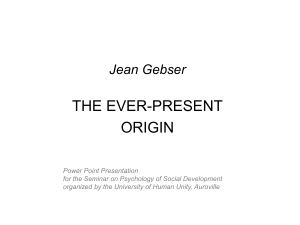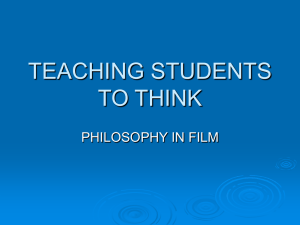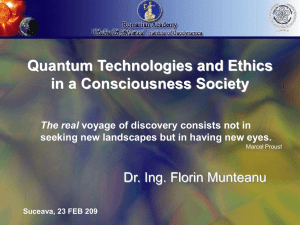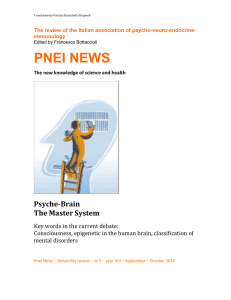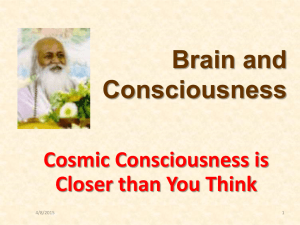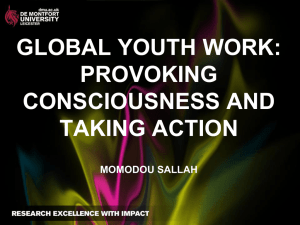Gebser Magic and Mythical Structures
advertisement
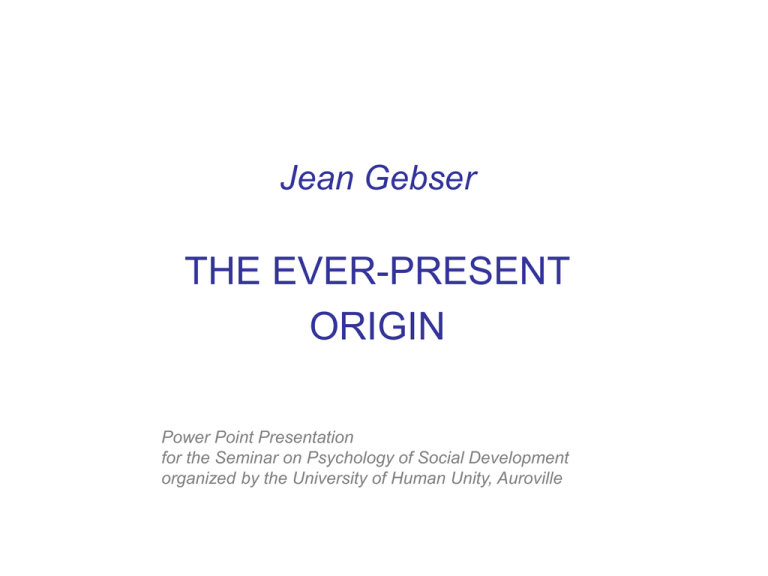
Jean Gebser THE EVER-PRESENT ORIGIN Power Point Presentation for the Seminar on Psychology of Social Development organized by the University of Human Unity, Auroville Magic and Mythical Structures of Consciousness Two fundamental principles of Gebser’s approach • • • • 1) Latency - what is concealed - is the demonstrable presence of the future. It includes everything that is not yet manifest, as well as everything which has again returned to latency. Since we are dealing here primarily with phenomena of consciousness and integration, we will also have to investigate questions of history, the soul and the psyche, time, space, and the forms of thought. Since the second part of this work is devoted to manifestations of the new consciousness, the first part must clarify questions relating to the manifestations of previous and present consciousness structures. We shall attempt to demonstrate the incipient concretion of time and the spiritual dimension which are preconditions of the aperspectival world. We shall also attempt to furnish evidence of the increasing efficacy of that spiritual reality (which is neither a mere psychic state nor an intellectual-rational form of representation). This will bring out the validity of our second guiding principle: 2) Transparency (diaphaneity) is the form of manifestation (epiphany) of the spiritual. Our concern is to render transparent everything latent "behind" and "before" the world - to render transparent our own origin, our entire human past, as well as the present, which already contains the future. We are shaped and determined not only by today and yesterday, but by tomorrow as well. The author is not interested in outlining discrete segments, steps or levels of man, but in disclosing the transparency of man as a whole and the interplay of the various consciousness structures which constitute him. This transparency or diaphaneity of our existence is particularly evident during transitional periods, and it is from the experiences of man in transition, experiences which man has had with the concealed and latent aspects of his dawning future as he became aware of them, that will clarify our own experiencing of the present. Gebser’s Fundamental Discoveries • The beginning of the perspectival perception of the mental (=spatial) structure of consciousness (Ancient Greeks and medieval Europe) out of latent unperspectival and pre-perspectival structures. (Francesco Petrarca, Leonardo de Vinci, etc.) • The emergence of aperspectival consciousness in the 20th century out of perspectival structure (Picasso etc.) operating within and by all the latent structures in a transparent way for the manifestation of the Spirit. • “Transparency (diaphaneity) is the form of manifestation (epiphany) of the spiritual.”- says Gebser. He cannot fully accept the rational, perspectival conception of progress and evolution, which is not taking into account the latent structures of our being. • He also declines the Orientalist view, which is, according to him, turned only towards the past (mythical structure) in search of the origin to escape from the manifestation (mainly Buddhism and Advaita). Sri Aurobindo on Evolution • We speak of the evolution of Life in Matter, the evolution of Mind in Matter; but evolution is a word which merely states the phenomenon without explaining it. For there seems to be no reason why Life should evolve out of material elements or Mind out of living form, unless we accept the Vedantic solution that Life is already involved in Matter and Mind in Life because in essence Matter is a form of veiled Life, Life a form of veiled Consciousness. The Life Divine, (Page 3) Structures of consciousness • Archaic ( Primal man, Protanthropos, Purusha of the Rig Veda, Adam Kadmon, of the Cabbala, Osiris of the Egyptian-Gnostics) • Magic (‘here the primal man becomes the maker’, vital impulse and instinct thus unfold and develop a consciousness in dealing with Nature; witchcraft and sorcery, totem and taboo are the natural means of freeing himself from Nature) (appr. before 10 000 BC) • Mythical (brings the awareness of the inner life of the soul, its history and its origin, the primal Myth) (appr. before 2500 BC) • Mental (‘It individualizes man from his previously valid world, emphasizing his singularity and making his ego possible.’(p.76) It introduces a perspectival perception of the world (1250-1500 AD) by spatializing time perception; it represents life by conceptualizing it, distancing man from his own nature.) • Integral (freedom from all the structures by their transparent rearrangement into one integral oneness of being) The structures of consciousness in the Mandukya Upanishad • • • • Jāgrata , a wakeful state, the outer consciousness. Svapna, a dream like state, with dreams being dreamed. Prajñā, a dream without dreaming, pure perception, not marred by the dreams coming from the interaction with the outer or inner world. Turiya, the state beyond all the three, in the pure transcendental consciousness, which somehow embodies all the three and transcends them all. The Magic structure of Consciousness has two major characteristics: • interwovenness or interconnectedness of the soul with nature (which implies egolessness in relation, timelessness and spacelessness in perception); • ‘an enormous attempt of the spirit to free oneself’ or to distinguish/ separate oneself in being and power, when there is a complete identification in consciousness with the surrounding, which constitutes to a great extent the very consciousness of pre-individual man. This attempt is translated in such actions as spells, curses, magic manipulations, interaction with all subliminal forces of Nature to influence weather, health (healing), events etc., hunting ceremonies, sacrifices and rituals, initiations and witchcraft etc. etc. In our age it is translated in terms of technology, which represents the attempt to liberation of man in a mechanical way from the mechanical enslavement of Nature (in the body, vital and partially in the mind). The Tower of Babel is the mythical image of this magic attempt. Properties of Magic structure of Consciousness • Man is always attending, hearing, hearkening, feeling and responding to a bigger body of environment as his own through: • spells, curses, magic formulas, and subliminal universal forces trying to influence weather, health (healing), events etc., making hunting ceremonies, sacrifices and rituals, initiations and witchcraft etc. etc., having powers of clairvoyance and clairaudience, a power of telepathy, etc. • It is manifested in herds, flocks, tribes, etc. And later in the mythical and mental structures as religious sects and philosophical schools, organisations and collective bodies, group soul, ethnos, nation, country etc. with its own particular group identity and symbols. Consciousness of the Magic structure • “In a sense one may say that in this structure consciousness was not yet in man himself, but still resting in the world. The gradual transfer of this consciousness which streams towards him and which he must assimilate from his standpoint, and the awakening world, which he gradually learns to confront (and in the confrontation there is something hostile), is something that man must master. • Man replies to the forces streaming towards him with his own corresponding forces: he stands up to Nature. He tries to exorcise her, to guide her; he strives to be independent of her; then he begins to be conscious of his own will. Witchcraft and sorcery, totem and taboo, are the natural means by which he seeks to free himself from the transcendent power of nature, by which his soul strives to materialize within him and to become increasingly conscious of itself.” (p.46) Transition from the Magic to the Mythical Structure • “We can, however, locate approximately the time of the mutation from the magic to the mythical structure, since a consciousness of time, however rudimentary, would have had to manifest itself before the mutation was possible. In accord with the magic structure, this would have been more a sense of time than a knowledge of it – a time-sense closely attuned to nature. When we speak of ‘time’ we are also speaking of ‘soul’. They both share energeia, and, to the extent that they are separable, they are both preforms of matter. We will return in a moment to this affinity or possible identity; here we would note that whereas the distinguishing characteristic of the magic structure was the emergent awareness of nature, the essential characteristic of the mythical structure is the emergent of awareness of soul. Magic man’s sleep-like consciousness of natural time is the precondition for mythical man’s coming to awareness of soul.” The primal urge to freedom of Soul involved • Gebser writes: “This remarkable and deeply inveterate impulse to be free from miracles, taboos, forbidden names, which, if we think back on the archaic period, represents in the magic a falling away from the once-prevailing totality; this urge to freedom and the constant need to be against something resulting from it (because only this “being against” creates separation, and with it, possibilities of consciousness) may be the answering reaction of man, set adrift on earth, to the power of the earth. It may be curse, blessing, or mission. In any case, it may mean: whoever wishes to prevail over the earth must liberate himself from its power.” (p.51) The Mythical structure as a transition towards the Mental structure • From the hearing of Magic structure to a concrete and objective seeing in the Mental consciousness man must undergo one more mutation of the Mythical structure, where he perceives himself as a soul located in the Heart, bringing out the imaginary of the Origin in the Primal Myth, and gaining the ability of self-expression in the Word, which is already an individualised expression though still of the Universal nature. So the self-expression in the Heart by the Word builds up gradually a mentality in him. It individualizes him more and more, until he becomes ready to perceive himself as a separate being: to see himself objectively. Two major characteristics of the Mythical structure: the Word and the Imagination of the Soul • • “The corresponding verb for mythos is mytheomai, meaning ‘to discourse, talk, speak’; its root, mu-, means ‘to sound’. But another verb of the same root, myein – ambivalent because of the substitution of a short ‘u’ – means ‘to close’, specifically to close the eyes, the mouth, and wounds.” (p. 65) “Thus the word is always a mirror of inner silence and myth a reflector of soul.” (p.67) The other distinct feature of the Mythical structure is ‘that it bears the stamp of imagination… Although still distant from space, the mythical structure is already on the verge of time. The imaginatory consciousness still alternates between magical timelessness and the natural cosmic periodicity. The farther myth stands removed from consciousness, the greater its degree of timelessness; its unreflective ground resembles the reverse side of a mirror. By contrast, the closer its proximity to consciousness, the greater emphasis on time; … This ambivalent relation between time and timelessness, which defies our rational understanding, once again finds its expression in the polarity of the mythical structure, for both forms simultaneously exist and complement each other.” (p.67) Two contentual aspects of the myths • The ‘astral-mythological’, related to the finding of the soul and its journey. • The natural is ‘being interpreted mostly in sexual-erotic terms’, (p.68), for it reflects the relation with the magic structure. Five major mythologemes • The Myths of the sea voyage (difficult and adventurous journey to the beyond to find oneself and one’s partner Soul-mate); • The Myth of Narcissus (finding one’s Soul); • The Myth of the Sun (finding the Origin, power of ‘the divine wrath’ as the dynamic truth, Ritam); • The Myth of the descent into Hades, Hell (cf. ‘The Descent into Night’, ‘The Entry into the inner countries’); • The Myth of the birth of Athena (sprung out of the head of Zeus as the birth of all-seeing Thought, with the eye of an owl, seeing in the dark) (pp. 69-73) The transition from the Magic to the Mythical and Mental structures with respect to the faculties of consciousness • Feeling/Hearing • Speaking/Imagining • Thinking/Seeing or we can paraphrase it as: • perceiving inwardly the nature as part of oneself through feelings and emotions; • expressing oneself as the inner soul by speech and imagination, already different from nature (from within to without) ; • perceiving outwardly oneself as a distinct part of nature by seeing objectively oneself and others and thinking about it.
